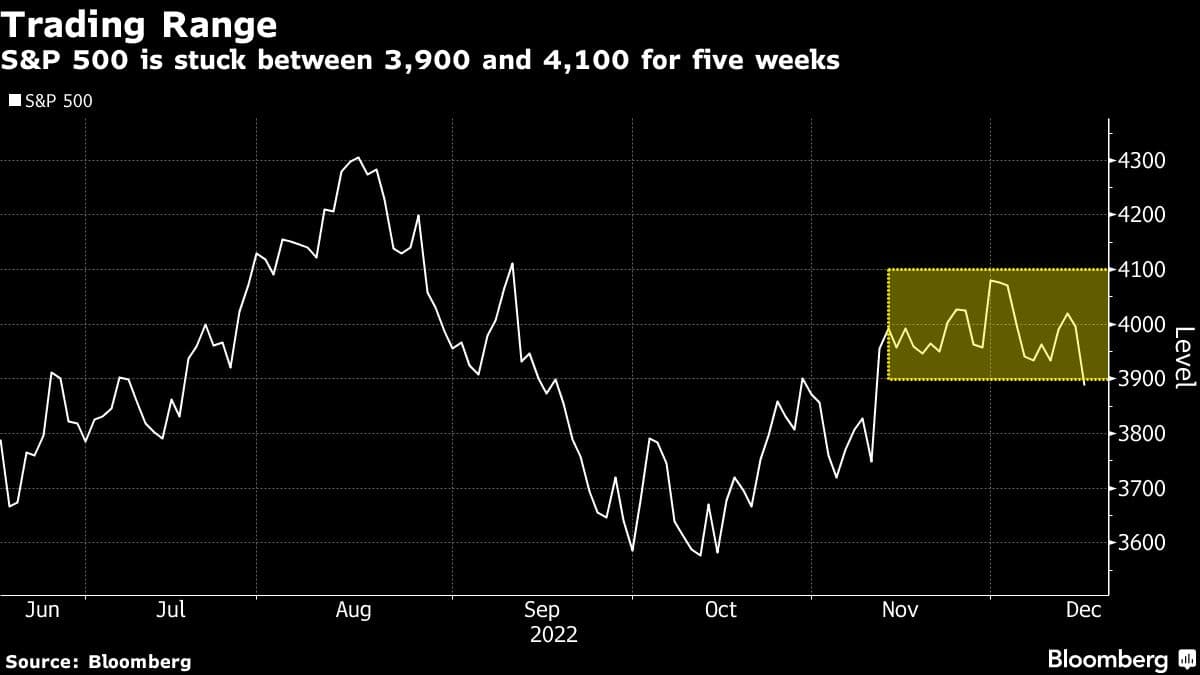
Bull statues and American flags for sale at a street vendor stall in front of the New York Stock Exchange (NYSE) in New York, U.S., on Monday, Sept. 20, 2021. The global stock rout sparked by investor angst over China?s real-estate sector and Federal Reserve tapering deepened on Monday, with U.S. stocks falling more than 2% and European equities tumbling the most in more than two months. Photographer: Michael Nagle/Bloomberg
Bulls reeling from the Federal Reserve’s still-hawkish tilt are about to lose a major force that helped tamp down turbulence in US stocks during this week’s macroeconomic drama.
An estimated $ 4 trillion of options is expected to expire Friday in a monthly event that in tends to add turbulence to the trading day. This time, with the S&P 500 stuck for weeks within 100 points of 4,000, the sheer volume provides a positioning reset that could turbocharge market moves. Given the brutal backdrop that emerged in recent days, from a raft of rate hikes by global central banks to signs the American economy is starting to flag, worries are mounting the expiration will act as an air pocket.
That’s how David Reidy, founder of First Growth Capital LLC, sees it playing out. In his view, the market has been mired in a “long gamma” state where options dealers need to go against the prevailing trend, buying stocks when they fall and vice versa.
Friday’s event “could break the tightness of the gamma exposure and lead to some dispersion, that is, room for the index to break out,” Reidy said. “That would be a downside move given yearend position adjustments and the macro recession view.”

Options tied to the 4,000 level on the S&P 500 account for the biggest chunk of open interest set to mature and acted as something of a tether for the index’s price in the weeks leading up to Friday, according to Brent Kochuba, founder of Spot Gamma.
Stocks were already under pressure Thursday as the European Central Bank joined the Fed in raising interest rates and warning of more pain to come. The S&P 500 sank 2.5%, closing below 3,900 for the first time in five weeks.
That sets up a pivotal day, when holders of options tied to indexes and individual stocks — whose notional value according to Goldman Sachs Group Inc. strategist Rocky Fishman is worth $ 4 trillion — will have to either roll over existing positions or start new ones.
The event this time coincides with the quarterly expiration of index futures in a process ominously known as triple witching. Added to that comes a rebalancing of benchmark indexes including the S&P 500. The combination tends to spark single-day volumes that rank among the highest of the year.
“Between expiration and rebalances, Friday will likely be the last ‘liquidity day’ of 2022,” said Chris Murphy, co-head of derivatives strategy at Susquehanna International Group.
Options traders were gearing up for turmoil going into this week’s report on consumer prices and the last Federal Open Market Committee meeting of the year. In a sign of heightened anxiety, the derivatives market did something unusual Monday with the Cboe Volatility index, a gauge of options cost known as VIX, jumping more than 2 points while the S&P 500 climbed 1.4%. That’s the biggest concerted gains since 1997.
“Essentially all of the options prices tied to Friday were extremely high, and very sensitive to implied volatility (and time decay) because they are expiring in just a few days,” SpotGamma’s Kochuba said. “Once the events passed, the implied volatility (i.e. value of these options) tanked, leading to hedging flows that brought mean reversion to markets.”
The dynamic was on display Wednesday, as a drop in the S&P 500 coincided with a slide in the VIX, again bucking the historic pattern of their moving in opposite directions.
That unwinding of hedging removed one market support and opened the door for more volatility, according to Danny Kirsch, head of options at Piper Sandler & Co.
“Now that the event has passed, the market is free to move more,” he said. “And the realization of higher-for-longer Fed is setting in, plus the high possibility of recession next year.”
